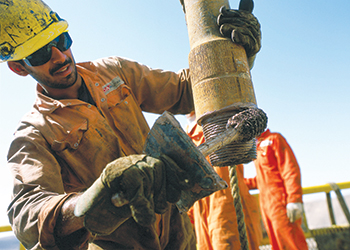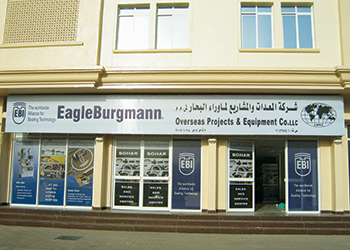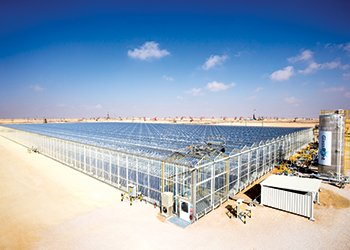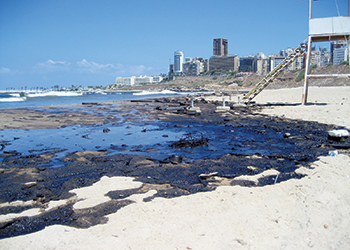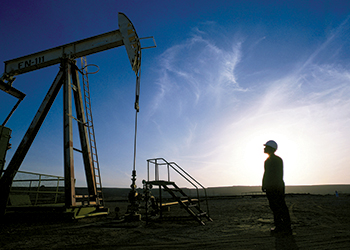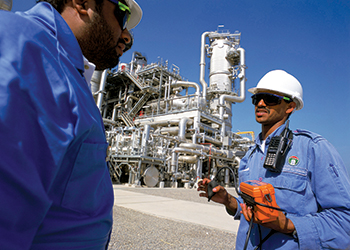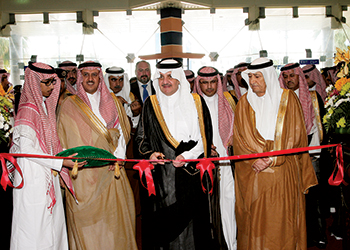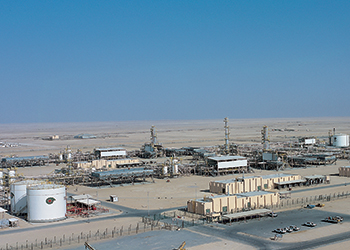
 PDO ... investments will continue
PDO ... investments will continue
Average oil production of PDO for 2015 was 588,937 bpd, the highest since 2005, 14,000 bpd above the planned target. Gas production was 83 million cubic metres a day
Petroleum Development Oman (PDO), Oman’s dominant oil and gas producer, aims to invest in excess of $10 billion in a trio of signature integrated schemes that are key to sustaining the company’s long-term hydrocarbon output.
All three mega ventures — the Rabab Harweel Integrated Project (RHIP), the Yibal Khuff integrated oil and gas facility, and the Budour integrated project —are making commendable headway in their planning and implementation, according to managing director Raoul Restucci. 'These are very large investments, which will probably total in excess of $10 billion over the next 5-10 years,' he says.
Restucci notes that the Rabab Harweel Integrated Project (RHIB) in particular continued to make 'impressive progress'.
'Work on the power plant is very advanced, so are the foundations and the wells. The contribution of Local Community Contractors (LCCs) is also very significant. As many as 12 LCC companies are working to prepare the site. There is good progress overall, good integration, and good safety; we will deliver on target.'
At Harweel in the south of Oman, PDO aims to harness part of Rabab’s sour gas to inject as miscible gas to produce oil from Harweel’s sour oil reservoirs.
Gas will be injected at sufficient pressure to allow it to mix with the oil, thereby making it less viscous and enable it to flow to the surface. This integration of the Harweel oil and Rabab gas components is slated for completion in 2019 with peak production of 36,000 barrels of oil per day (bpd) targeted thereafter.
Rabab-Harweel, Yibal Khuff and Budour are oil and gas reservoirs located in the Greater Birba in the south of PDO’s Block 6 concession — an area that could potentially contribute nearly a third of the company’s oil production in the future.
At Yibal Khuff, PDO has received shareholder approval for the simultaneously development of a number of sour oil and gas reservoirs.
A significant part of the investment in the project will go towards the construction of an integrated oil and gas facility, billed as one of the largest and technically most complex ventures to be implemented by PDO.
The presence of H2S in the hydrocarbons requires sizable investment in state-of-the-art sulphur removal technology.
 |
Rumhy ... no cut in oil production |
At Budour, plans for the first-ever use of water injection in a sour oil field are being reviewed following the discovery of additional gas reservoirs in the same area.
According to Restucci, PDO is now looking for an optimal solution for the field. The company’s success in identifying additional gas reserves in the field now requires that the reservoir be tested before the main project is suitably expanded, he says.
PDO, which accounts for around 70 per cent of the country’s total crude oil production, is looking at producing 600,000 barrels of crude oil per day (bpd), says Restucci.
'PDO is trying to raise its output to 600,000 bpd, which we originally planned for 2019,' Restucci says.
'In January to March, we were not able to reach our target because of the bad weather and we hope we can catch up in the coming months,' he adds.
'With the sharp fall in global oil prices, PDO still managed to surpass expectations right across the business,' he continues.
Average oil production of PDO for 2015 was 588,937 bpd, the highest since 2005 and almost 14,000 bpd above the planned target.
Gas production was 83 million cubic metres a day, one million cubic metres above the planned target, as the company stepped up its effort to meet growing national gas demand.
Speaking about the current oil price, Restucci says; 'We are near $50 now; for PDO it is a very profitable number.'
According to him, the average cost of production for the first grade oil is $5 per barrel, for the second grade it is $12 and for the third grade is $25.
'Most of our projects are very attractive, all of our projects generate double digit returns even at the low prices,' Restucci confirms.
Ruling out any cut in oil production, Dr Mohammed Bin Hamad Al Rumhy, Minister for Oil and Gas, says that the sultanate’s average oil production in 2016 could exceed 990,000 bpd.
Production is expected to be between 980,000 and 990,000 bpd or slightly better than that,' he says on the sidelines of a function where 195 Omanis graduated as welders in a Petroleum Development Oman (PDO)-funded programme.
Rumhy says he was aware of some initiatives for a coordinated cut in production to stabilise the oil market, but we are really spectators'.
Oman had offered to cut its crude oil production by 5 to 10 per cent if other producers did the same. He says he expected oil prices to increase by the end of the year.
 |
Restucci ... achieving targets |
Work on the proposed undersea pipeline that will carry 1 bcf of gas from Iran to the sultanate was ‘progressing’. The minister had recently stated that front end engineering and design (Feed) should be over by the second quarter of 2016 and by end of the first quarter of 2017 engineering, procurement and construction (EPC) work will start and take two years for completion. The sultanate hopes to start receiving Iranian gas by 2019.
About the proposed Middle East to India Deepwater Gas Pipeline (Meidp) connecting Iran and India being routed overland through the sultanate, Rumhy says it was 'a good idea'.
He says they were discussing the land route option with the Indians and will consider accepting gas from the MEIDP into the Oman gas system. All options are open for discussion and we are very receptive to any idea that comes from friendly states like Iran and India,' the minister adds.
Once there is gas from the Iran-Oman pipeline and possibly from MEIDP, the sultanate can set up a fourth LNG liquefaction train at Qalhat, Rumhy says. At present, Oman LNG operates three trains with capacity of 10.4 mtpa.
Al Rumhy says there were no plans to list shares of PDO or Oman Oil Company. Saudi Aramco has recently confirmed that it was considering a stock market flotation to increase revenue in a low oil price environment.
About PDO’s production, Restucci says that in 2015 it produced oil and gas at 1.29 million barrels of oil equivalent per day. In 2014, PDO had an oil production rate of 570,534 bpd.
In PDO’s Khulud West reservoir, 'well testing had been successful and we are going into the next development stage'. That target was to produce 5 million standard cubic metres per day from Khulud West in phase 1 and 2 and PDO was working on the long term field development plan, he adds.
Restucci says some expatriate job contracts will not be extended this year but otherwise there will not be any major reductions in the company’s workforce. The company is targeting 7,000 new jobs in 2016 and will drill more than 500 wells.
Meanwhile, PDO confirms that it set a new combined oil, gas and condensate production record of 1.29 million barrels of oil equivalent per day (boepd) in 2015.
 |
Oman Oil ... tapping new fields |
The company says it was confident of reaching a new sustainable long-term oil production plateau of 600,000 bpd, well ahead of its original 2019 target, to support revenue generation.
At the same time, it is pledging to intensify its cost-control programme to combat the effects of the low oil price environment with an efficiency drive across its operations and has reduced planned expenditure this year by $1.6 billion.
The average PDO daily oil production for 2015 was 588,937 bpd, the highest since 2005 and almost 14,000 bpd above the planned target. Gas production was 83 million cumd, one million cubic metres above the planned target as the company stepped up its effort to meet growing national gas demand.
Commenting on the 2015 performance, Restucci says: 'With the sharp fall in global oil prices dominating our thoughts and deeds, I am pleased to be able to report that PDO still managed to surpass expectations right across the business.
'As the nation’s largest oil and gas producer, our staff are fully aware of the vital role they play in generating the resources and revenue needed to power Oman and their commitment to stay the course and deliver value, despite the worsening economic situation, was truly impressive.
'Ensuring our business is sustainable is a long-term goal of PDO but the current low oil price environment also underscores the critical importance of sustainability in the present. PDO has seized the opportunity to continue to drive business improvement and operate more efficiently, while maintaining our overarching commitment to safety.
'The current environment requires us to leave no stone unturned to boost near-term cash-flow and we have reduced 2016 expenditure by $1.6 billion. We’ll continue to work with our contractors to identify further cost reduction opportunities and optimise expenditure in light of the country’s economic challenges.
'Importantly, we have been able to maintain our growth plans and will continue to actively pursue and accelerate projects which can generate increased revenues, with early monetisation of discoveries and opportunities, top quartile recovery, meeting government gas requirements, delivering projects on promise, and ensuring stakeholder expectations are fulfilled.'
PDO added significant reserves and contingent resources, in excess of annual production, in 2015. There was a substantial oil discovery at Sadad North in southern Oman amounting to 44.5 million barrels of commercial contingent reserves (CCRs), contributing to a total of 109 million barrels of CCRs from new discoveries. Additionally, there was a 2 per cent rise in Stock Oil Initially In Place (STOIIP) to 67.8 billion barrels and a 4 per cent increase in Gas Initially In Place (GIIP) to 78.2 trillion cubic feet (tcf).
On the gas supply front, the Mabrouk Southwest discovery, yielded 0.38 tcf of commercial contingent reserves. The field was discovered as a satellite to the Mabrouk field in the Barik and Miqrat reservoirs in the northern part of PDO’s Block 6 concession area. By the year’s end, the Tayseer gas field discovery in southern Oman further added in place volumes of 0.93 (tcf) of gas and 117 million barrels of condensate.
PDO achieved the majority of its corporate project delivery milestones on or ahead of plan, and all were delivered within the year, with ground-clearing on the landmark Miraah solar energy project, the largest of its type in the world at peak capacity, already complete. The company is now working to continuously improve its project delivery with a simplification of standards and further collaboration with contractors which will enhance delivery, the use of the Omani supply chain and improve cost effectiveness.
The company is currently operating a variety of commercial-scale enhanced oil recovery (EOR) projects that include chemical EOR, miscible gas injection and thermal applications. It will also continue the maturation of more promising and novel EOR technologies through laboratory and field testing.
However, because of the resource-intensive nature and higher cost of tertiary recovery mechanisms, much emphasis has been placed on accelerating conventional oil and gas opportunities instead of additional short-term expansion of EOR projects. This optimisation is very much enabled by the several development choices we have in our portfolio and means that EOR is now expected to account for approximately 25 per cent of PDO oil production by 2025, as opposed to last year’s projections of 33 per cent by 2023.
On the safety front, the company recorded a 14 per cent improvement in Lost Time Injury Frequency at 0.28 per million manhours, albeit with two work-related fatalities. There was also a 54 per cent fall in Tier-1 Asset Integrity-Process Safety (AI-PS) incidents and a 30 per cent drop in the overall number of motor vehicle incidents.
Restucci notes: 'Although we are pleased to see an improved safety performance, there is still much work to do if we are to achieve our Goal Zero aspiration of no harm to people, environment or assets.
'To further embed the safety culture in PDO, we will place more emphasis on visible leadership and compliance, intervention and respect, supported by improved reporting and simpler, more pervasive training.'
During his presentation Restucci highlighted a string of PDO achievements last year. These included the creation of 7,200 employment, training and re-deployment opportunities for Omanis with PDO contractors and the award of contracts worth more than $3.7 billion to nationally registered firms.
The company has also ramped up its support of domestic small and medium enterprises, including 190 active Local Community Contractors and four Super Local Community Contractors. The SLCCS now have a total capital worth of RO23.2 million and more than 9,400 shareholders drawn from the communities where they operate.
Restucci says: 'Despite the recessionary pressures, it has been more important than ever to pursue our In-Country Value (ICV) programme to build a sustainable Omani industrial/private sector base able to compete on the international stage and retain more of the industry’s wealth in the sultanate.
'The creation of employment and training opportunities for Omanis remains a strategic priority for PDO and we are determined to play our part in helping the thousands of nationals who come onto the job market each year to find meaningful and rewarding work.'
Project Prism, PDO’s industry-first initiative into the welfare of more than 30,000 contractor personnel has been stepped up with the aim of confidentially interviewing workers from 200 companies this year about a wide range of topics including safety, pay, training, medical care, food, accommodation and human resources provision in the field.
In 2015, PDO stayed true to its aspirations to be a good corporate citizen, pledging financial support to a range of community and educational initiatives, including school building and further training and marketing support for the Banat Oman social
enterprise.
This has now trained more than 300 women from low-income backgrounds in a variety of handicrafts, giving them the opportunity to make a better living.
Oman’s 2016 crude oil and condensate output is expected to average 1 mbpd, up from 924,000 bpd in 2012 and a little above 710,000 bpd in 2007, compared to 970,000 bpd in 2000. Natural gas production in 2016 is expected to average 122-123 mcmd, from 120 mcmd obtained in 2015 which was 5 mcmd above the 2014 level. About 17.7 per cent of the sultanate’s natural gas output is associated with oil production, up from 103 mcmd in 2013. The main concessionaire in the country, PDO, accounts for most of the liquids and gas production in the sultanate.
Limited reserves of conventional oil and gas and complex geology have compelled PDO and the other producers of liquids in Oman to depend more on all possible options for EOR than ever before to
maintain output.
Consequently, E&P operating costs keep rising and the Ministry of Oil and Gas (MOG) is concentrating more on the maintenance of a liquids production plateau than on setting ambitious production targets. Oman is pinning its hopes on the development of its fairly large non-conventional gas.
PDO has substantial focus on increasing its production with its territory oil recovery activities. The company uses three different EOR techniques to increase production from its mature oil and gas fields.
Its EOR techniques include miscible gas injection, thermal recovery and chemical recovery. Miscible gas injection technique involves injection of gas into the reservoir into which oil can dissolve. Thermal recovery methods employed by the company are in-situ combustion, cyclic steam injection, steamflood and thermally assisted gas-oil gravity drainage techniques.
Thermal techniques are used for converting the thick viscous oil into more mobile and easier to extract form with the help of heat.
Chemical EOR technique is used for converting water to thicker fluid with the help of thickening agent.
This highly viscous water is then used for pushing the oil out from the reservoir. PDO focuses on increasing the recovery rates through these recovery techniques. The company has six EOR trials in operation or in engineering execution.
Two EOR projects are already on-stream:at Qarn Alam and Harweel.
It produces oil at Qarn Alam through a thermally assisted gas oil gravity drainage recovery mechanism.
In April, the Harweel miscible gas injection project came on-stream with its first year production at some 25,000 bpd with an extensive ramp-up planned.
In FY2014, the company completed five tests of EOR technologies including Fahud steam, Amin steam, Amin polymer, Marmul back-produced polymer, and Habhab solvent, which provided meaningful data on which to base quality decisions on future EOR in these targeted fields.



































































